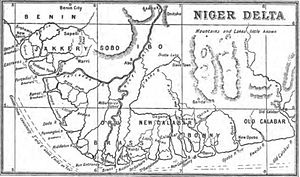
The Ijaw people, otherwise known as the Ijo people, are an ethnic group found in the Niger Delta in Nigeria, with significant population clusters in Bayelsa, Delta, and Rivers. They also occupy Edo, Ondo, and parts of Akwa Ibom.

The Escravos River is a river in southern Nigeria, close to the city of Warri. "Escravos" is a Portuguese word meaning "slaves" and the area was one of the main conduits for slave trade between Nigeria and the United States in the 18th century. The Escravos is a distributary of the Niger River, it flows for 57 kilometres (35 mi), ending at the Bight of Benin of the Gulf of Guinea where it flows into the Atlantic Ocean. Chevron, a major US oil company, has its main Nigerian oil production facility at the mouth of the Escravos River. This oil terminal pumps approximately.
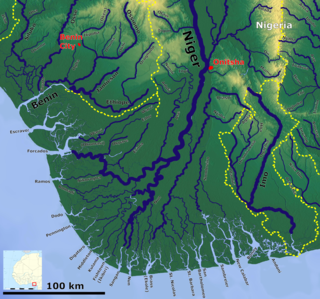
The Forçados River is a channel in the Niger Delta, in southern Nigeria. It flows for approximately 198 kilometres (123 mi) and meets the sea at the Bight of Benin in Delta State. It is an important channel for small ships. The Forçados River splits from the Niger River at Toru-Abubou near Agbere Town in Sagbama Local Government Area of Bayelsa State, the same point as the Nun River.
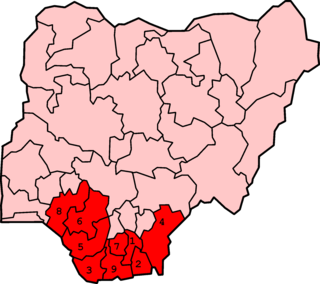
The Niger Delta is the delta of the Niger River sitting directly on the Gulf of Guinea on the Atlantic Ocean in Nigeria. It is located within nine coastal southern Nigerian states, which include: all six states from the South South geopolitical zone, one state (Ondo) from South West geopolitical zone and two states from South East geopolitical zone.
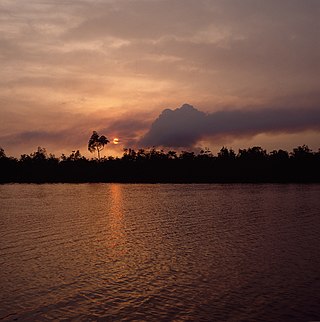
Bayelsa is a state in the South South region of Nigeria, located in the core of the Niger Delta. Bayelsa State was created in 1996 and was carved out from Rivers State, making it one of the newest states in the federation. The capital, Yenagoa, is susceptible to high risk of annual flooding. It shares a boundary with Rivers State to the east and Delta State to the north across the Niger River for 17 km and the Forçados River for 198 km, with the waters of the Atlantic Ocean dominating its southern borders. It has a total area of 10,773 square kilometres (4,159 sq mi). The state comprises eight local government areas: Ekeremor, Kolokuma/Opokuma, Yenagoa, Nembe, Ogbia, Sagbama, Brass and Southern Ijaw. The state is the smallest in Nigeria by population as of the 2006 census. Being in the Niger Delta, Bayelsa State has a riverine and estuarine setting, with bodies of water within the state preventing the development of significant road infrastructure.
Yenagoa is a Local Government Area and capital city of Bayelsa State, southern Nigeria. It is located at the southern part of the country at coordinates 4°55′29″N6°15′51″E.

The Movement for the Emancipation of the Niger Delta (MEND) is a decentralised militant group in the Niger Delta region of Nigeria. MEND's actions – including sabotage, theft, property destruction, guerrilla warfare, and kidnapping – are part of the broader conflict in the Niger Delta and reduced Nigeria's oil production by 33% between 2006-07.

The current conflict in the Niger Delta first arose in the early 1990s over tensions between foreign oil corporations and a number of the Niger Delta's minority ethnic groups who feel they are being exploited, particularly the Ogoni and the Ijaw. Ethnic and political unrest continued throughout the 1990s despite the return to democracy and the election of the Obasanjo government in 1999. Struggle for oil wealth and environmental harm over its impacts has fueled violence between ethnic groups, causing the militarization of nearly the entire region by ethnic militia groups, Nigerian military and police forces, notably the Nigerian Mobile Police. The violence has contributed to Nigeria's ongoing energy supply crisis by discouraging foreign investment in new power generation plants in the region.
The Izonlanguages, otherwise known as the Ịjọ languages, are the languages spoken by the Izon people in southern Nigeria.
Environmental issues in the Niger Delta are caused by its petroleum industry. The delta covers 20,000 km2 (7,700 sq mi) within wetlands of 70,000 km2 (27,000 sq mi) formed primarily by sediment deposition. Home to 20 million people and 40 different ethnic groups, this floodplain makes up 7.5% of Nigeria's total land mass. It is the largest wetland and maintains the third-largest drainage basin in Africa. The Delta's environment can be broken down into four ecological zones: coastal barrier islands, mangrove swamp forests, freshwater swamps, and lowland rainforests. Fishing and farming are the main sources of livelihoods for majority of her residents.

Burutu is a Local Government Area in Delta State, Nigeria. It lies on the coast of the Niger Delta on two sides of the Forcados River, a channel of the River Niger, 30 kilometres upstream from the Bight of Benin. It has served as a link between river transport and the sea when the Royal Niger Company established a base there in the late 19th century. People living in this region are mostly of the Izon ethnicity.
The Bassan tribe (Basan) of the Ijaw people lives in western Bayelsa State, Nigeria. Bassan settlements include: Ezetu, Koloama, Sangana, Foropah, Ukubie, Lubia, Azuzuama, Akparatubo, and Ekeni.
The Mein tribe of the Ijaw people lives along the Forcados River in Delta State, Nigeria. The Mein trace their origins to Benin City, via parts of the central Niger Delta. Important Mein settlements include Ogobiri and Kiagbodo.
Twon-Brass, previously known simply as Brass or Brasstown, is a community on Brass Island in the Nun River estuary of Southern Bayelsa State, Nigeria, in the Brass Local Government Area. Twon Brass was found in the year, 1895 The royal Chief is Alfred Diete-Spiff. The town is on the east shore of the Brass River, one of the branches of the Nun River, which in turn is a branch of the Niger River.
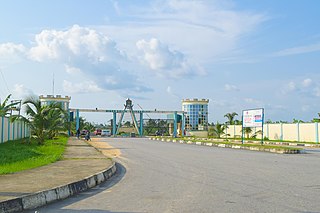
Niger Delta University (NDU) is in Wilberforce Island, Bayelsa State in the southern part of Nigeria. It was established in 2000. It is a Bayelsa state government-funded university. In 2002, It was established by Chief DSP Alamieyeseigha, then governor of Bayelsa state. It has two main campuses, one in the state capital, Yenagoa, which contains the law faculty, and the other in Amassoma. It also has its teaching hospital known as Niger Delta University Teaching Hospital (NDUTH) in Okolobiri.

Akassa, is a settlement at the southernmost tip of Nigeria in Bayelsa State where the Nun River estuary meets the Atlantic Ocean. It has a lighthouse that has stood since 1910.

The Brass River is one of the branches of the Nun River, which in turn is a branch of the Niger River, in the Niger Delta in Nigeria. In the 19th century the river was an important trading route, first for slaves and later for palm oil. Brass River Crude Oil is named for a refinery on the river.
The Niger Delta Avengers (NDA) is a militant group in the Niger Delta region of Nigeria. The group publicly announced their existence in March 2016.
The 2016 Niger Delta conflict is an ongoing conflict around the Niger Delta region of Nigeria in a bid for the secession of the region, which was a part of the breakaway state of Biafra. It follows on-and-off conflict in the Christian-dominated southern Niger Delta in the preceding years, as well as an insurgency in the Muslim-dominated northeast.

Nigeria has extensive mangrove forests in the coastal region of the Niger Delta. Considered one of the most ecologically sensitive regions in the world, the Niger Delta mangrove forest is situated within a deltaic depositional environment. These mangrove forests serve a critical role in regional ecological and landscape composition, and support subsistence gathering practices, and market-based income opportunities. Anthropogenic development threatens the survival of Niger Delta mangrove populations.

